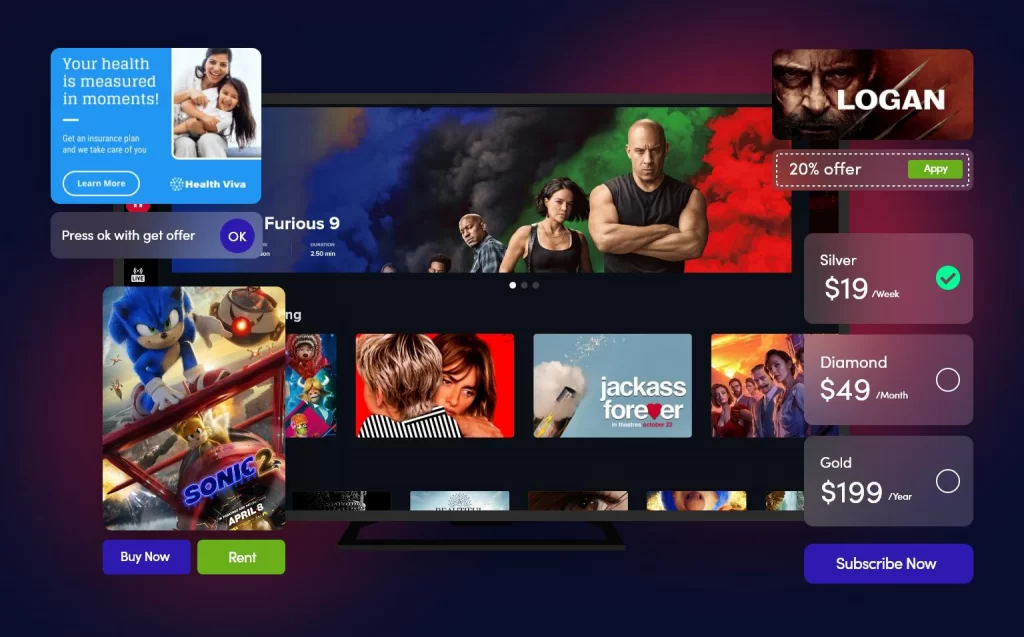Examine This Report about Apollo Group Tv
Table of ContentsAll About Apollo Group TvThe Apollo Group Tv PDFsApollo Group Tv Things To Know Before You BuyThe smart Trick of Apollo Group Tv That Nobody is Talking About
In this situation, as opposed to having three-minute commercial places throughout a 30-minute tv program, TV shows might change to one where a customer will be called for to have a regular monthly subscription, to ensure that they cen view targeted banner advertisements. This kind of marketing currently occurs on the net, and the quantity of information television firms collect permits them to do a lot the very same.Explain the impact of sponsors on program material. Describe the major fads amongst the broadcasting and wire networks. When tv remained in its early stage, producers designed the brand-new medium on radio. Popular radio reveals such as police drama Dragnet and western cowboy collection Gunsmoke were adjusted for television, and new television shows were sponsored by solitary advertisers, simply as radio programs had actually been.
Today, the television sector is even more intricate. Programs are sponsored by multiple advertisers; programs is managed by major media conglomerates; and the 3 major networks no much longer control the airwaves but instead share their viewers with numerous wire channels. A number of elements make up these trends within the market, including technological growths, government guidelines, and the creation of brand-new networks.

Some Known Incorrect Statements About Apollo Group Tv
Established in 1969, (PBS) developed out of a report by the Carnegie Payment on Educational Television, which checked out the duty of instructional, noncommercial television on society. Public tv was also meant to supply universal accessibility to tv for customers in rural areas or audiences that might not manage to pay for exclusive tv solutions.
The period in between 1950 and 1970 is traditionally recognized as the. In addition to a little portion of airtime managed by public television, the 3 significant networks (recognized as the Big Three) controlled the television market, jointly accounting for greater than 95 percent of prime-time viewing. In 1986, Rupert Murdoch, the head of international firm Information Corp, introduced the Fox network, challenging the prominence of the Big Three.
Targeting young and minority audiences with programs such as Buffy the Vampire Killer, Moesha, Dawson's Creek, and The Wayans Bros., the new networks wanted to attract stations away from their old network affiliations. Rather than duplicating the success of Fox, UPN and WB battled to make an effect. Unable to draw in numerous affiliate stations, the 2 new networks got to less households than their bigger competitors since they were inaccessible in some smaller cities.
This choice led the way for the development of cable motion picture channels, contributing to the exponential growth of cable television in the 1980s and 1990s. apollo tv. Further deregulation of cord in the 1984 Cable Communications Policy Act eliminated constraints on cable rates, making it possible for operators to charge what they wanted for cord solutions as long as there was efficient competitors to the service (a criterion that over 90 percent of all wire markets might satisfy)
The Apollo Group Tv Statements
.png)
Having developed the first "superstation," Turner broadened his world by starting 24-hour news network CNN in 1980. At the end of the year, 28 nationwide programming solutions were offered, and the wire transformation had actually started. Over the next decade, the market went through a period of fast development and appeal, and by 1994 customers might pick from 94 standard and 20 premium cable television services.
Number 9 - http://www.askmap.net/location/7112535/indonesia/apollo-group-tv.16 Increased competitors from wire networks has caused a steady decline in the networks' audience ratings. Throughout the 1950s, the price of producing a single tv program increased as shows ended up being much longer and production prices soared. Sponsorship on network tv moved from single sponsorship, in which a program was totally sustained and produced by one marketer, to several sponsorship, in which advertisers acquired 1- or 2-minute spots on the show
Pick one of the Big Four networks and publish out its once a week shows routine. See the network's prime-time programs over the course of a week, keeping in mind the target market for each show.
Some Ideas on Apollo Group Tv You Need To Know

Linear TV, frequently referred to as conventional broadcast TV, incorporates cable and satellite tv. It's called "linear" since material complies with a predetermined programs schedule, unlike on-demand web content which the specific audience makes a decision to view based upon their own preferences and schedule. When you ask, "What is direct TV?", think about it as the timeless method of seeing TV that has been around for years.